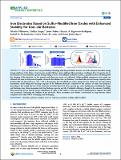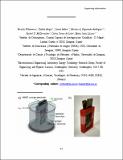Por favor, use este identificador para citar o enlazar a este item:
http://hdl.handle.net/10261/282061COMPARTIR / EXPORTAR:
 SHARE SHARE
 CORE
BASE CORE
BASE
|
|
| Visualizar otros formatos: MARC | Dublin Core | RDF | ORE | MODS | METS | DIDL | DATACITE | |

| Título: | Iron electrodes based on sulfur-modified iron oxides with enhanced stability for iron-air batteries |
Autor: | Villanueva, Nicolás CSIC; Alegre Gresa, Cinthia CSIC ORCID; Rubín, Javier CSIC ORCID; Figueredo-Rodríguez, H. A.; McKerracher, Rachel; Ponce de León, Carlos; Lázaro Elorri, María Jesús CSIC ORCID | Palabras clave: | Electrodes Hydrogen evolution Iron−air batteries Passivation Stability Sulfur-modified |
Fecha de publicación: | 19-oct-2022 | Editor: | American Chemical Society | Citación: | ACS Applied Energy Materials 5(11): 13439-13451 (2022) | Resumen: | Iron–air systems are a very promising technology with the potential to become one of the cheapest and safest energy storage solutions of the future. However, iron anodes still face some challenges like passivation, resulting in loss of capacity, due to the formation of nonconductive species during cycling as well as the hydrogen evolution reaction, a parasitic reaction interfering with the charging of the electrode. In the present work these two issues are addressed: Sulfur-modified mesoporous iron oxides are obtained and used as hot-pressed negative electrodes for alkaline iron–air batteries. Iron electrodes present average capacity values between 400 and 500 mA h g Fe–1 for ∼100 h of operation, the S-modified iron oxides being the most stable ones. An exponential deactivation model fitting the discharge capacity of the different electrodes compared to the number of cycles was proposed. According to the model, the best of the electrodes loses less than 0.5% of its capacity per cycle. Furthermore, doubling the charge and discharge rates allows increasing both the discharge capacity and the Coulumbic efficiency, though at the expense of stability. This manuscript proves that the proper distribution of sulfur on the surface of the iron oxide is fundamental to suppress the HER and passivation, enhancing the stability of the electrode. These properties were further corroborated in long test-runs which comprised more than 400 h of charging and discharging. | Descripción: | 7 figures.-- Supporting information available. | Versión del editor: | http://dx.doi.org/10.1021/acsaem.2c02123 | URI: | http://hdl.handle.net/10261/282061 | DOI: | 10.1021/acsaem.2c02123 | E-ISSN: | 2574-0962 |
| Aparece en las colecciones: | (INMA) Artículos (ICB) Artículos |
Ficheros en este ítem:
| Fichero | Descripción | Tamaño | Formato | |
|---|---|---|---|---|
| acsaem.2c02123.pdf | Artículo principal | 12,46 MB | Adobe PDF |  Visualizar/Abrir |
| ae2c02123_si_001.pdf | Información suplementaria | 2,27 MB | Adobe PDF |  Visualizar/Abrir |
CORE Recommender
SCOPUSTM
Citations
2
checked on 01-abr-2024
WEB OF SCIENCETM
Citations
2
checked on 27-feb-2024
Page view(s)
38
checked on 22-abr-2024
Download(s)
93
checked on 22-abr-2024
Google ScholarTM
Check
Altmetric
Altmetric
Este item está licenciado bajo una Licencia Creative Commons



